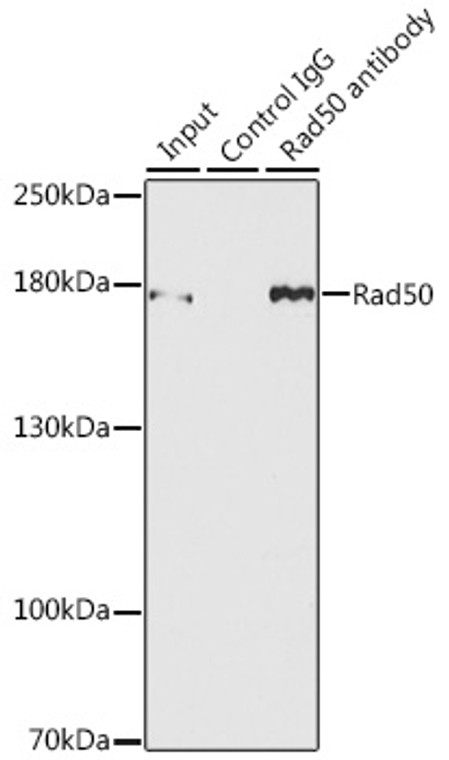| Host: | Rabbit |
| Applications: | WB/IHC/IP |
| Reactivity: | Human/Mouse/Rat |
| Note: | STRICTLY FOR FURTHER SCIENTIFIC RESEARCH USE ONLY (RUO). MUST NOT TO BE USED IN DIAGNOSTIC OR THERAPEUTIC APPLICATIONS. |
| Short Description: | Rabbit polyclonal antibody anti-Rad50 (1-100) is suitable for use in Western Blot, Immunohistochemistry and Immunoprecipitation research applications. |
| Clonality: | Polyclonal |
| Conjugation: | Unconjugated |
| Isotype: | IgG |
| Formulation: | PBS with 0.02% Sodium Azide, 50% Glycerol, pH7.3. |
| Purification: | Affinity purification |
| Dilution Range: | WB 1:500-1:1000IHC-P 1:50-1:200IP 1:20-1:50 |
| Storage Instruction: | Store at-20°C for up to 1 year from the date of receipt, and avoid repeat freeze-thaw cycles. |
| Gene Symbol: | RAD50 |
| Gene ID: | 10111 |
| Uniprot ID: | RAD50_HUMAN |
| Immunogen Region: | 1-100 |
| Immunogen: | A synthetic peptide corresponding to a sequence within amino acids 1-100 of human Rad50 (NP_005723.2). |
| Immunogen Sequence: | MSRIEKMSILGVRSFGIEDK DKQIITFFSPLTILVGPNGA GKTTIIECLKYICTGDFPPG TKGNTFVHDPKVAQETDVRA QIRLQFRDVNGELIAVQRSM |
| Tissue Specificity | Expressed at very low level in most tissues, except in testis where it is expressed at higher level. Expressed in fibroblasts. |
| Function | Component of the MRN complex, which plays a central role in double-strand break (DSB) repair, DNA recombination, maintenance of telomere integrity and meiosis. The complex possesses single-strand endonuclease activity and double-strand-specific 3'-5' exonuclease activity, which are provided by MRE11. RAD50 may be required to bind DNA ends and hold them in close proximity. This could facilitate searches for short or long regions of sequence homology in the recombining DNA templates, and may also stimulate the activity of DNA ligases and/or restrict the nuclease activity of MRE11 to prevent nucleolytic degradation past a given point. The complex may also be required for DNA damage signaling via activation of the ATM kinase. In telomeres the MRN complex may modulate t-loop formation. |
| Protein Name | Dna Repair Protein Rad50Hrad50 |
| Database Links | Reactome: R-HSA-2559586Reactome: R-HSA-5685938Reactome: R-HSA-5685939Reactome: R-HSA-5685942Reactome: R-HSA-5693548Reactome: R-HSA-5693554Reactome: R-HSA-5693565Reactome: R-HSA-5693568Reactome: R-HSA-5693571Reactome: R-HSA-5693579Reactome: R-HSA-5693607Reactome: R-HSA-5693616Reactome: R-HSA-6804756Reactome: R-HSA-69473Reactome: R-HSA-912446Reactome: R-HSA-9701192Reactome: R-HSA-9704331Reactome: R-HSA-9704646Reactome: R-HSA-9709570Reactome: R-HSA-9709603 |
| Cellular Localisation | NucleusChromosomeTelomereLocalizes To Discrete Nuclear Foci After Treatment With Genotoxic Agents |
| Alternative Antibody Names | Anti-Dna Repair Protein Rad50 antibodyAnti-Hrad50 antibodyAnti-RAD50 antibody |
Information sourced from Uniprot.org
12 months for antibodies. 6 months for ELISA Kits. Please see website T&Cs for further guidance










